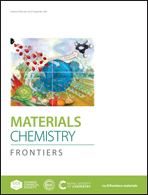Highly efficient deep-blue fluorescent OLEDs based on anthracene derivatives with a triplet–triplet annihilation mechanism
Abstract
Blue organic luminescent materials are highly desired for high-quality full-color displays, but are still quite insufficient. Herein, two new luminescent molecules, 4-(10-(3-(9H-carbazol-9-yl)phenyl)-2,6-di-tert-butylanthracen-9-yl)benzonitrile (mCz-TAn-CN) and 4-(2,6-di-tert-butyl-10-(3,5-di(9H-carbazol-9-yl)phenyl)anthracen-9-yl)benzonitrile (m2Cz-TAn-CN), are designed and synthesized. Their photophysical properties, electronic structures, electrochemical behaviors, thermal stabilities and electroluminescence performances are comprehensively studied. The non-doped organic light-emitting diode (OLED) based on mCz-TAn-CN provides stable deep-blue light [Commission Internationale de l’Eclairage (CIEx,y) = 0.14, 0.12] and a maximum excellent external quantum efficiency (ηext,max) of 7.03%, contributed by the triplet–triplet annihilation process. The doped OLED of m2Cz-TAn-CN radiates bluer light (CIEx,y = 0.14, 0.09) with an outstanding ηext,max of 7.28%. These results demonstrate that both new molecules are promising candidates for application in deep-blue OLEDs.



 Please wait while we load your content...
Please wait while we load your content...